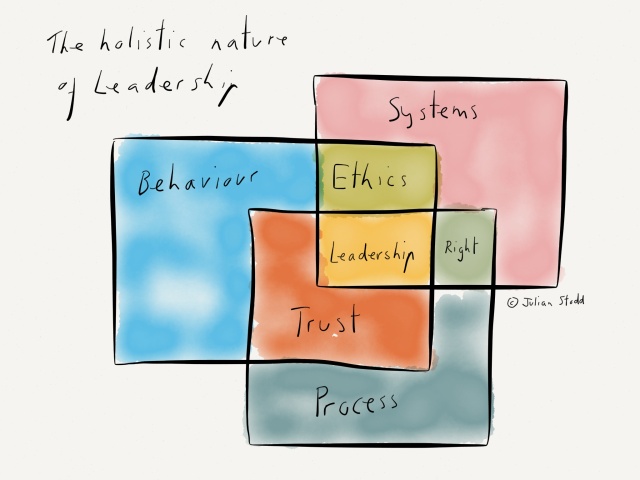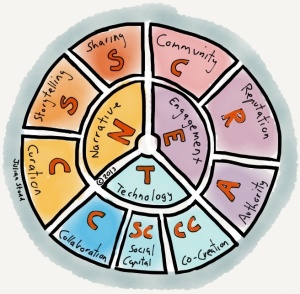The Social Age rewards agility: the ability to frame and reframe problems, to deploy our communities and experiment, question and react at speed. It’s less about mastery of process, more about communication and collaboration. Social Leaders demonstrate a rounded skill set: a holistic mastery of these skills and a consistent demonstration of these behaviours over time. Reputation is founded upon this consistency.

We can reduce leadership to be viewed within different frames, but it’s only in the holistic application that we can be effective.
In traditional terms, it’s a mixture of hard and soft skills: sure, there is an element of technology that needs to be mastered, but there is very little process. Social Leadership is more about storytelling, sharing and reciprocating than it is about performance reviews and competency frameworks. It may exist alongside these things, but the authority is garners is consensual, granted through the community.
Agile organisations need frameworks for control that are balanced by capabilities of social leadership. Rely too much on control and you become stagnant, lethargic, unable to be agile.
A large component of Social Leadership is to do what’s right: what’s right for the organisation and what’s right for individuals. To do what’s right even beyond what the regulation of law tells us we must do. It’s about propagating fairness and equality through all our decision making.
We can reduce leadership to individual frames and, indeed, seek to master the skills in each, but in it’s application, it’s something that is lived holistically. It’s the exhibited behaviours of Social Leadership that make the social leader. It’s less about talk, more about action.
The NET Model outlines nine core components, grouped into three Dimensions. The first, ‘Narrative‘, is about taking a stance, about deciding how you will be understood, what you will be known for. We curate accordingly, shape stories in line with this and share them appropriately. The skills learnt around Narrative enable the Social Leader to act with consistency and reflect on the consequences of their actions.The second Dimension is about Engagement: it’s about understanding the role and purpose of communities and the many different ways we engage within them. Right in the middle of the model sits Reputation: wrought through the stance we take, the stories we tell and the ways in which we contextualise and share them. Reputation cannot be faked: the authenticity in our stories can only be lived, and authenticity, for both organisations and individuals is a core part of trust and integrity. Authority, founded upon that reputation, is socially granted and moderated.
Finally comes Technology, but not the skills of operating systems, rather the ways that the technology facilitates the conversations, facilitates us to be better. Social Capital, right in the middle of this section, explores notions of humility and equality in Social Leadership: doing what’s right and the responsibilities that come with our social authority.
Responsibility comes with authority: the prize is not the power. The prize is the fairness we create when we exercise it.
We can view leadership in frames, separate components, different competencies, but it’s in it’s exercising that our reputation is forged and it’s in the exercise of power that we do right or wrong.
Understand the frames, but strive to do right.
For organisations, understand the role of technology, the role of process and control, but create the permissions to do right, the spaces to explore and the mechanisms to reward and recognise social authority.
It’s the way to agility.
The Social Leadership Handbook is available in Hardback copy from here.



Reblogged this on Experiences that will help you and commented:
East or west if you have this skills you are best!!!!!!!!!!!!!!!!!!!!!!!!!!!!!!
Pingback: The Frames of Leadership Julian Stodd | E-Learn...
Mostly agree, but what I think you will find, Julian, is that leaderships is a large part “authenticity” and a big dollop simple, every-day honesty.
All of the things you’ve mentioned are true – can’t deny those – but saying what mean, meaning what say and not ‘making-it-up’, carries a lot of weight with people.
I purchasing your book! I love this post! Great stuff
Reblogged this on Out of My Mind and commented:
Julian Stodd’s piece “The Frames of Leadership” was interesting reading, indeed, but it made me wonder, how widespread are these concepts from “The Social Age?” When and how is the average, non-union employee “rewarded.”
I’m looking back on years in the work force, most recently as a supervisor in the billing department of a large, non-profit behavioral health organization. I was proud to be a member of the staff, because I valued the services the organization provides, including crisis intervention, residential facilities for detox and recovery, a variety of family services and day programs for individuals with a variety of behavioral challenges. These services are not only important, they’re crucial to the wellbeing of any large community.
What surprised me was the way we employees were treated; I’d expected more from an organization with a socially conscious mission statement. Instead, the practices mirrored the model I’ve seen time and again and which is, sadly, “the norm” for most US corporations. Employees are doing the work previously assigned to two or three people, the staff is kept at “skeleton crew” level to save money, the lunch hour is now half an hour, employees who use their sick time are reprimanded, pay check deductions for benefits such as healthcare increase every year and the annual raise averages 3%, if you’re fortunate enough to be working for a company where wages haven’t been frozen.
When employers treat the workforce this way, the atmosphere may be pleasant on the surface, but if you talk with individuals, you’ll find they’re disgusted, exhausted and see their job as “doing time” until they’re able to retire, which for many folks is not at age 65. I’m sure there are some enlightened employers, but in general I think those working “9 to 5” are less than satisfied with their leaders. TGIF, indeed!
Really enjoyed this and re-blogged it! Good stuff!
Thanks Laura 🙂
Pingback: The Ladder to Leadership | Julian Stodd's Learning Blog
Pingback: Preparing for Creativity+Tech+Learning | My Notebook
Pingback: The Leadership Myth | Julian Stodd's Learning Blog
Pingback: A Guide to Developing Social Leadership | Julian Stodd's Learning Blog
Pingback: An Imperfect Humanity? | Julian Stodd's Learning Blog
Pingback: Holistic Adaptation: the Mindset of Future Organisations | Julian Stodd's Learning Blog